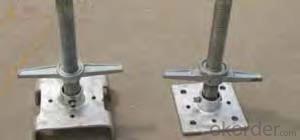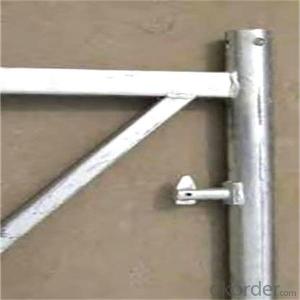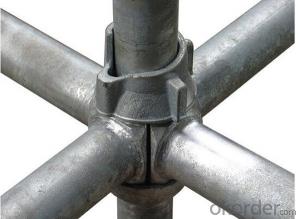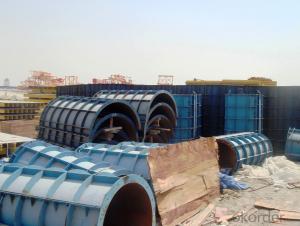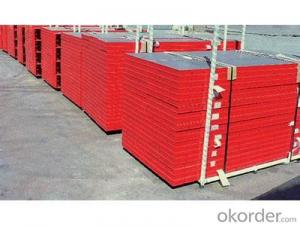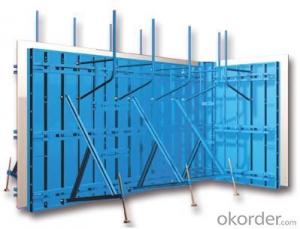Aluminum Scaffolding Beam Formwork Pipe Roll for Scaffolding with Low Price
- Loading Port:
- Tianjin
- Payment Terms:
- TT OR LC
- Min Order Qty:
- 10000 set
- Supply Capability:
- 50000 set/month
OKorder Service Pledge
OKorder Financial Service
You Might Also Like
Aluminum Scaffolding Beam Formwork Pipe Roll for Scaffolding with Low Price
Scaffolding Screw Jack Formwork Scaffolding China Low Price
Developing with new technology materials, steel formworks is no longer a must in construction concrete process. More and more buildings are established with plastic formworks. And workers love this new formworks much more.
The advantages of plastic formworks:
Scaffolding Screw Jack Formwork Scaffolding China Low Price
1.First of all--light
Yes it is the first advantage of plastic formwork. It wins the great praise of both contractors and workers.
The biggest panel is 120×1500px,weights 10.5kg only. It can be lift and set up by one person easily, which means there is no need for cranes on site.Saves a lot of cost and time.
2.Easy set up
Different size of panels can firmly locked by simply turn the special handles to 90 degree. The Panels has rib on the back, which makes the system need not traditional wood blocks and nails. The panels have holes to fit tie rod, guarantee the strength of the whole system.
3.Modularity
Modular formworks composed by different size of panels,the main item is 120×1500px panel,which is used for the large area of walls and slabs. There are also small size of panels like 10×1500px,20×1500pxcm,25×1500px,inner corner 20×20×1500px and outer corner 10×5×1500px.Due to the variety of panel size, the system can form almost all size walls 120×1500px panel of multiply by 125px. The material of modular formwork is PC-ABS mixed with special glass fibers which enable panels to hold high pressures.
4.Strength
The handles are made by high strength Nilon, each panel locked by at least 4 handles, which makes the whole system strong enough to pour 1000px walls.
Aluminum Scaffolding Beam Formwork Pipe Roll for Scaffolding with Low Price
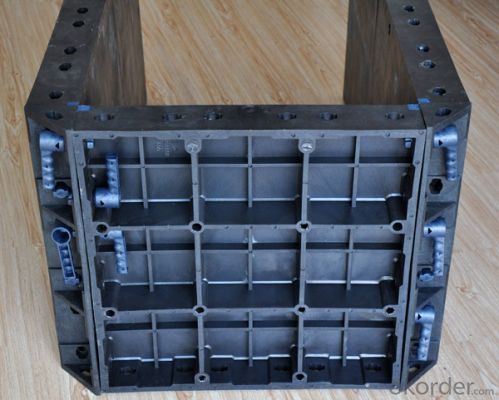
Aluminum Scaffolding Beam Formwork Pipe Roll for Scaffolding with Low Price
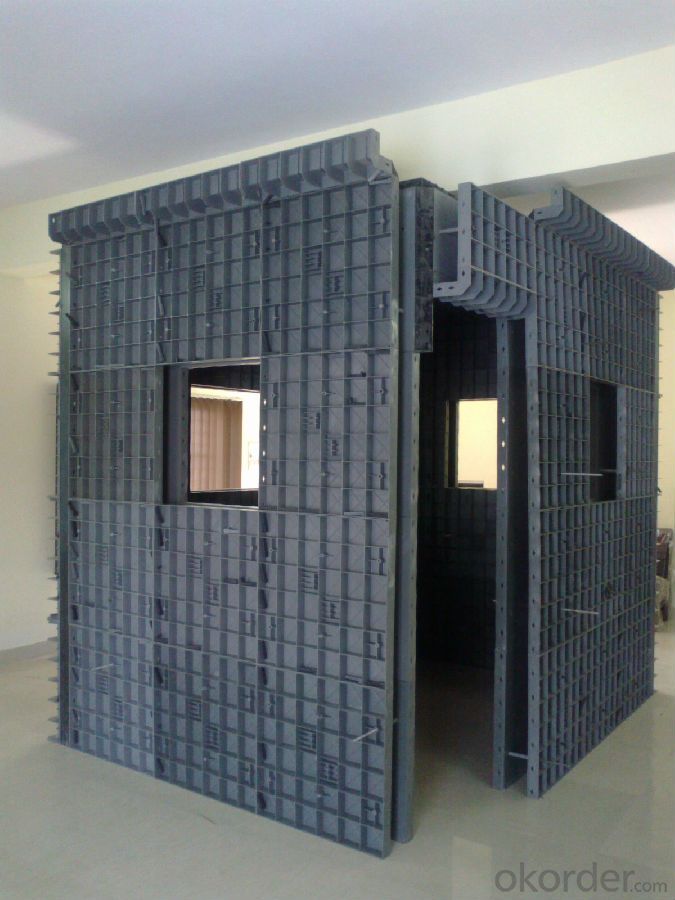
Aluminum Scaffolding Beam Formwork Pipe Roll for Scaffolding with Low Price
- Q:Steel frame wood fire doors and steel doors is a concept
- Steel wood fire doors that wood fire doors. The door is made of double layer board, which is coated with a galvanized iron sheet or a double layer wood board with a single side of a gypsum board, and a double layer board and a double layer of asbestos can be used. The new standard fire door fire door provisions of steel wood burning wood or difficult burning wood products making door frame and door frame, door panel, door fire insulation materials filling material is non-toxic and harmless to the human body and steel, and with fire hardware fittings with certain refractory properties of the door. The fire resistance of the fire doors are above 1.2H.
- Q:What are the different types of safety barriers and guardrails used with steel frame formwork?
- To ensure the safety and protection of workers, various safety barriers and guardrails are commonly employed alongside steel frame formwork. These include: 1. Handrails: Horizontal barriers installed along the formwork edges, handrails provide stable support for workers on elevated platforms or scaffolds. They prevent accidental falls and offer a secure grip. 2. Toeboards: Vertical barriers placed on the sides and ends of the formwork, toeboards prevent tools, equipment, or materials from falling off the platform. They safeguard workers below and reduce the risk of accidents. 3. Midrails: Additional horizontal barriers positioned between the handrail and toeboard, midrails create a second barrier to prevent workers from accidentally falling through the gap. 4. Mesh panels: Often used alongside handrails and toeboards, mesh panels are made of durable wire mesh. They secure the sides of the formwork and protect workers from potential hazards by preventing objects from falling off. 5. Safety nets: Installed below the working platform, safety nets act as an additional safety barrier. In the event of an accident, they catch falling objects or workers, minimizing the risk of injury or damage. In summary, these safety measures and guardrails, when properly installed and regularly inspected, establish a secure working environment, prevent falls, and safeguard workers from potential hazards and accidents.
- Q:How does steel frame formwork handle concrete curing in humid conditions?
- Steel frame formwork is an excellent choice for handling concrete curing in humid conditions due to its inherent properties. Firstly, steel is highly resistant to moisture, which means it can withstand the humid environment without getting damaged or deteriorating. This makes it a reliable option for formwork, as it will remain structurally stable throughout the curing process. Furthermore, steel frame formwork provides a solid and stable support system for the concrete during curing. This ensures that the concrete maintains its shape and integrity, even in high humidity. The steel frame offers strength and rigidity, preventing any deformation or sagging of the formwork. In humid conditions, the risk of mold or mildew growth is increased. However, steel formwork does not provide a suitable environment for these organisms to thrive. Its non-porous surface and resistance to moisture make it less prone to mold or mildew growth, ensuring a hygienic and safe curing process. Additionally, steel formwork allows for better air circulation and ventilation, which is crucial during concrete curing. The open design of the formwork allows moisture to evaporate more efficiently, aiding the curing process and reducing the risk of surface defects such as cracking or uneven drying. This is especially important in humid conditions where the evaporation rate may be slower. Overall, steel frame formwork is a suitable choice for concrete curing in humid conditions. It resists moisture, provides stability, prevents mold growth, and allows for proper ventilation, ensuring a successful and durable concrete curing process.
- Q:How to get PKPM steel frame
- General steel column you can choose GB H model HW, the beam with HN models, the load, then, the pattern plate constant load 1, live load depends on the specific situation.
- Q:Are there any limitations to the number of reuses for steel frame formwork panels?
- Steel frame formwork panels have limitations when it comes to reusability. Despite being a durable and strong material, steel is not impervious and can deteriorate over time due to repeated use. There are several factors that contribute to these limitations: 1. Fatigue: The constant exposure to different loads and stresses with each use can lead to fatigue, which weakens the steel and can eventually cause failure. 2. Corrosion: Steel is prone to corrosion when exposed to moisture, chemicals, or certain environmental conditions. This corrosion can compromise the structural integrity of the panels, making them unsuitable for reuse. 3. Wear and tear: The repeated process of assembling, disassembling, and transporting the steel formwork panels can result in wear and tear. This can cause deformation, cracks, or other forms of damage, making the panels less effective and safe for reuse. 4. Surface imperfections: During the pouring of concrete, the formwork panels may acquire surface imperfections like scratches, dents, or residue buildup. These imperfections can impact the quality of future concrete pours and may require the panels to be repaired or replaced. 5. Changes in construction requirements: Over time, construction methods, designs, and building codes may change, rendering older steel formwork panels obsolete. This limits their reusability as they may no longer meet the updated requirements. To ensure the safe and effective reuse of steel frame formwork panels, regular inspections, maintenance, and repairs are essential. It is also crucial to adhere to manufacturer guidelines and industry best practices. These guidelines and practices should take into account the condition and usage history of each panel, as well as the specific requirements of the construction project.
- Q:Can steel frame formwork be used for the construction of industrial processing facilities?
- Yes, steel frame formwork can be used for the construction of industrial processing facilities. Steel frame formwork is known for its strength and durability, making it suitable for heavy-duty construction projects like industrial processing facilities. It provides a stable structure that can withstand the weight of machinery, equipment, and the overall load that these facilities typically require. Additionally, steel frame formwork can be easily customized to meet the specific requirements of the project, allowing for efficient construction and ensuring a precise fit for the desired layout. Overall, the use of steel frame formwork in the construction of industrial processing facilities is a viable option that offers numerous benefits in terms of strength, durability, and flexibility.
- Q:What are the key safety features of steel frame formwork?
- The key safety features of steel frame formwork include: 1. Durability: Steel is a strong and sturdy material that can withstand heavy loads and external forces, ensuring the safety of workers and the structure itself. 2. Stability: The steel frame formwork system provides excellent stability due to its rigid structure. It can resist shifting or collapsing during concrete pouring, minimizing the risk of accidents. 3. Easy assembly and disassembly: Steel frame formwork is designed for quick and easy installation and removal. The components can be easily connected and disconnected, reducing the time workers spend on the construction site and minimizing the chances of accidents. 4. Adjustable design: Steel frame formwork systems often feature adjustable components, such as telescopic props and adjustable brackets. This allows for precise positioning and alignment, ensuring the formwork is secure and stable. 5. Safety accessories: Steel frame formwork is often equipped with safety accessories such as handrails, toe boards, and safety nets. These accessories provide additional protection for workers, preventing falls and injuries. 6. Fire resistance: Steel is a non-combustible material, making steel frame formwork highly resistant to fire. This feature enhances the overall safety of the construction site and reduces the risk of fire-related accidents. 7. Load-bearing capacity: Steel frame formwork is designed to withstand heavy loads, ensuring the safety of workers and preventing any structural failures. This feature is particularly important in high-rise constructions or projects with significant load requirements. 8. Compatibility with other safety systems: Steel frame formwork can be easily integrated with other safety systems, such as scaffolding or fall protection equipment. This ensures a comprehensive safety setup on the construction site, reducing the risk of accidents and injuries. Overall, the key safety features of steel frame formwork make it a reliable and secure option for construction projects. Its durability, stability, easy assembly, adjustable design, safety accessories, fire resistance, load-bearing capacity, and compatibility with other safety systems all contribute to creating a safe working environment for construction workers.
- Q:What are the different types of concrete reinforcement that can be used with steel frame formwork?
- The different types of concrete reinforcement that can be used with steel frame formwork include rebar, wire mesh, and fiber reinforcement. Rebar, which stands for reinforced bar, is commonly used to add strength and stability to the concrete. Wire mesh, made of intertwined steel wires, is used to distribute loads and prevent cracks. Fiber reinforcement, such as synthetic fibers or steel fibers, is added to improve the concrete's durability and resistance to shrinkage and cracking.
- Q:Are there any limitations to the height or width of structures that can be constructed using steel frame formwork?
- Yes, there are limitations to the height and width of structures that can be constructed using steel frame formwork. The primary limitation is the maximum load-bearing capacity of the steel frame itself. Steel frames are designed to support a certain amount of weight, and exceeding this limit can result in structural failure or collapse. Therefore, the height and width of a structure must be within the load-bearing capacity of the steel frame formwork. Another limitation is the availability of suitable steel frame formwork systems in larger sizes. While steel frames can be fabricated to accommodate a wide range of dimensions, there may be practical limitations to producing extremely large or complex structures using this method. The availability and cost of larger steel frame formwork systems may also be a factor to consider when determining the height and width of a structure. Finally, local building codes and regulations may impose specific limitations on the height and width of structures constructed using steel frame formwork. These regulations are put in place to ensure the safety and stability of buildings, and failure to comply with these limitations can result in legal consequences. Overall, while steel frame formwork offers great flexibility and strength in construction, there are limitations to consider in terms of load-bearing capacity, availability of suitable systems, and compliance with building regulations.
- Q:Can steel frame formwork be used for the construction of recreational facilities?
- Yes, steel frame formwork can be used for the construction of recreational facilities. Steel frame formwork offers strength, durability, and flexibility, making it suitable for various construction projects, including recreational facilities. It provides a stable framework for concrete pouring, allowing for the creation of complex shapes and designs. Additionally, steel frame formwork can be easily disassembled and reused, making it a cost-effective and efficient choice for constructing recreational facilities.
1. Manufacturer Overview |
|
|---|---|
| Location | |
| Year Established | |
| Annual Output Value | |
| Main Markets | |
| Company Certifications | |
2. Manufacturer Certificates |
|
|---|---|
| a) Certification Name | |
| Range | |
| Reference | |
| Validity Period | |
3. Manufacturer Capability |
|
|---|---|
| a)Trade Capacity | |
| Nearest Port | |
| Export Percentage | |
| No.of Employees in Trade Department | |
| Language Spoken: | |
| b)Factory Information | |
| Factory Size: | |
| No. of Production Lines | |
| Contract Manufacturing | |
| Product Price Range | |
Send your message to us
Aluminum Scaffolding Beam Formwork Pipe Roll for Scaffolding with Low Price
- Loading Port:
- Tianjin
- Payment Terms:
- TT OR LC
- Min Order Qty:
- 10000 set
- Supply Capability:
- 50000 set/month
OKorder Service Pledge
OKorder Financial Service
Similar products
New products
Hot products
Related keywords
